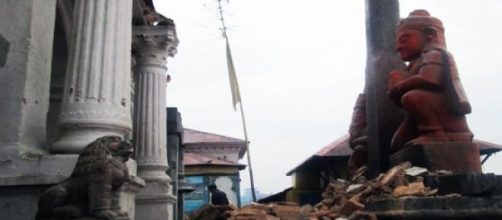Just two weeks after the devastating 7.8 magnitude quake that wreck havoc in Nepal, a major aftershock hit the country again yesterday. It brought down entire villages and sent the surviving population into panic, as more aftershocks may come - and a worst earthquake is not entirely ruled out.
The 7.3 magnitude quake hit 68km west of Namche Bazaar, close to Mount Everest, and half a dozen aftershocks followed. It killed at least 65 people and injured over 1,900. A U.S. Marine helicopter on a rescue mission also went missing near Charikot in the aftermath.
"The aftershock today [yesterday] was big, probably the biggest since the earthquake on April 25th," Lourenço Macedo Santos, a UK resident helping in Nepal, told Blasting News. "It was very scary. The insecurity feeling is back. I didn't get out of the hotel out of precaution, but I assume people ran back to the city parks, fearing their houses will collapse," he added. People are scared of additional aftershocks, he said, "especially during the night," and in fact that's the reason why the death toll wasn't so big this time - there are thousands of people living in tents, out in open fields. They have poor living conditions, but feel safer because there are no walls or roofs to bury them.
In Charikot, the most affected area, landslides threw rocks and mud into the roads, and some villages, like Jhume, have had 100% of their houses destroyed. Villagers witnessed the destruction, but most of them survived (in Jhume, three people died).
The bad news is that the fear is justified, because there is a serious risk of new earthquakes in the short term. That's what one of the world's most influential seismologist, Lucy Jones, explained Blasting News, stating that Tuesday's earthquake was "normal" within expectations. "Of course aftershocks will continue. Probably not as big as this, but it's possible to have another M7 [magnitude 7]," the US Geological Survey adviser revealed. "About 20% of mainshocks have an aftershock within 0.5 units of magnitude (i.e., a M7.3 after a M7.8 7.8-7.3 = 0.5)," she further told us.
According to the British Geological Survey, the second earthquake was "detected strongly" by seismometers across the UK. In addition to Nepal, Tuesday's quake was also felt in India, where it killed 17 people, Bangladesh, and Tibet, where one person died. The death toll is still being assessed, but it is fortunately not even close to what happened two weeks ago: 8,150 people died, close to 18,000 were injured and 600,000 homes were destroyed. Several historical places are now reduced to crumbles and multiple avalanches stormed Mount Everest, killing dozens of climbers.
When asked if the UK is at risk of suffering such a devastating event, expert Lucy Jones is clear: "almost undoubtedly not.
But the UK does have earthquakes, just much smaller." According to the British Geological Survey, 20 to 30 earthquakes are felt every year, and around 100 are recorded by instruments, but most of them don't have any consequences. "That earthquake happened at a plate tectonic boundary and there is not plate boundary in the UK," Dr. Jones adds. "Italy and Greece are the European countries with active plate boundaries. They have had magnitude 7 earthquakes in the past."

